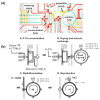Microfluidics for positron emission tomography probe development
- PMID: 20643021
- PMCID: PMC3744222
Microfluidics for positron emission tomography probe development
Abstract
Owing to increased needs for positron emission tomography (PET), high demands for a wide variety of radiolabeled compounds will have to be met by exploiting novel radiochemistry and engineering technologies to improve the production and development of PET probes. The application of microfluidic reactors to perform radiosyntheses is currently attracting a great deal of interest because of their potential to deliver many advantages over conventional labeling systems. Microfluidics-based radiochemistry can lead to the use of smaller quantities of precursors, accelerated reaction rates, and easier purification processes with greater yield and higher specific activity of desired probes. Several proof-of-principle examples along with the basics of device architecture and operation and the potential limitations of each design are discussed. Along with the concept of radioisotope distribution from centralized cyclotron facilities to individual imaging centers and laboratories ("decentralized model"), an easy-to-use, stand-alone, flexible, fully automated, radiochemical microfluidic platform can provide simpler and more cost-effective procedures for molecular imaging using PET.
Figures







References
-
- Phelps ME, editor. PET: Molecular Imaging and its Biological Applications. New York: Springer; 2004.
-
- Welch MJ, Laforest R, Lewis JS. Production of non-standard PET radionuclides and the application of radiopharmaceuticals labeled with these nuclides. In: Schubiger A, Lehmann L, Friebe M, editors. PET Chemistry: The Driving Force in Molecular Imaging. Berlin: Springer; 2007. pp. 159–81. - PubMed
-
- Maecke HR, Andre JP. 68Ga-PET radiopharmacy: A generator-based alternative to 18F-radiopharmacy. In: Schubiger A, Lehmann L, Friebe M, editors. PET Chemistry: The Driving Force in Molecular Imaging. Vol. 62. Berlin: Springer; 2007. pp. 215–42. - PubMed
-
- Dehdashti F, Flanagan FL, Mortimer JE, et al. Positron emission tomographic assessment of “metabolic flare” to predict response of metastatic breast cancer to antiestrogen therapy. Eur J Nucl Med. 1999;26:51–56. - PubMed
Publication types
MeSH terms
Substances
Grants and funding
LinkOut - more resources
Full Text Sources
Other Literature Sources
Miscellaneous
